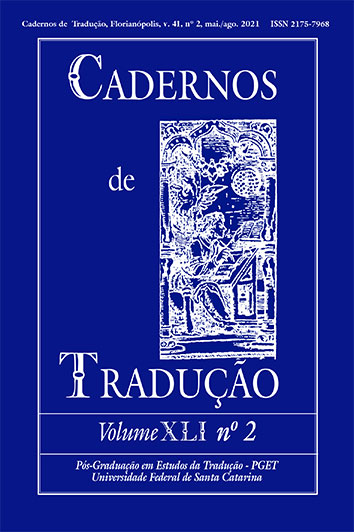Para além do visível: pela adoção de um paradigma emancipatório em audiodescrição
DOI:
https://doi.org/10.5007/2175-7968.2021.e71544Abstract
A Audiodescrição (AD) é uma modalidade de tradução que visa tornar materiais audiovisuais acessíveis. Seu público primário é formado por pessoas cegas ou com baixa visão para as quais o recurso é uma fonte de informação e lazer. Nos últimos anos, a qualidade das descrições oferecidas e sua adequação ao público-alvo têm se tornado questões de extrema relevância, levando pesquisadores a repensar certos parâmetros que vêm guiando a área. Um desses pontos a serem revistos é o caráter compensatório tradicionalmente atribuído à AD, segundo o qual o audiodescritor passa a ser “o olho” de quem não vê e a AD o instrumento que compensa a “perda” da visão. A ideia de que a experiência de videntes e pessoas com deficiência visual deva ou possa ser igualada, e de que esse deva ser o objetivo final da AD, acaba por resgatar conceitos há muito abandonados, como, por exemplo, o ideal de “equivalência”. Neste trabalho discutimos as raízes e consequências negativas dessa prática, bem como apresentamos um paradigma alternativo: o paradigma emancipatório. Sob esse novo viés, a AD supera tendências assistencialistas, contribuindo para que seu público tenha maiores condições de fruir produtos audiovisuais a seu próprio modo.
Riferimenti bibliografici
Asociación Española de Normalización y Certificación. UNE 153020: Audiodescripción para personas con discapacidad visual. Requisitos para la audiodescripción y elaboración de audioguías. Madrid: AENOR, 2005.
Bedny, Marina; Pascual-Leone, Alvaro; Dodell-Feder, David; Fedorenko, Evelina; e Saxe, Rebecca. “Language processing in the occipital cortex of congenitally blind adults”. Procedings of the National Academy of Science of the United States of America (PNAS) 108.11 (2011): 4429-4434. Portal PNAS. 17/02/20. https://www.pnas.org/content/108/11/4429.
Gabrilli, Mara. Cartilha da Lei Brasileira de Inclusão. N.p: n.p., 2016. Site da senadora Mara Gabrilli. https://maragabrilli.com.br/wp-content/uploads/2019/07/Guia-LBI-int.pdf.
Carletto, Ana Cláudia; Cambiaghi, Silvana. Desenho universal: um conceito para todos. São Paulo: Instituto Mara Gabrilli, 2008. Site da senadora Mara Gabrilli. 17/02/20. http://maragabrilli.com.br/wp-content/uploads/2016/01/universal_web-1.pdf.
Chauí, Marilena. “Janela da Alma, Espelho do Mundo”. O Olhar, Novaes, Adauto (org.). São Paulo: Companhia das Letras, 1998. 31-63.
Classen, Constance. Worlds of sense: exploring the senses in history and across cultures. London/New York: Routledge, 1993.
Costa, Larissa Magalhães. Audiodescrição em filmes: história, discussão conceitual e pesquisa de recepção. Tese de doutorado – PUC-Rio, 2014.
Díaz Cintas, Jorge. “Audiovisual translation today: a question of accessibility for all”. Translating Today. 4 (2005): 3-5. Impressa
Diniz, Débora; Barbosa, Lívia; Santos, Wenderson. “Deficiência, direitos humanos e justiça”. SUR – Revista Internacional de Direitos Humanos. 6.11 (2009): 65-77. Portal SciELO. 17/02/20. http://www.scielo.br/pdf/sur/v6n11/04.pdf.
Fryer, Louise. Putting it into words: the impact of visual impairment on perception, experience and presence. Tese de doutorado – University of London, 2013.
Hyks, Veronika. “Audio description and translation: two related but different skills”. Translating Today. 4 (2005): 6-8. Impressa
Kastrup, Virginia. “‘Será que cegos sonham?’: o caso das imagens táteis distais”. Psicologia em Estudo. 18.3 (2013): 431-440. Portal SciELO. 17/02/20. http://www.scielo.br/pdf/pe/v18n3/v18n3a04.pdf.
Lambert, S.; Sampaio, E.; Mauss, Y.; Scheiber, C. “Blindness and brain plasticity: contribution of mental imagery? An fMRI study”. Cognitive Brain Research. 20.1 (2004): 1-11. Portal do NCBI. 17/02/20. https://www.ncbi.nlm.nih.gov/pubmed/15130584.
Limbach, Christiane. La neutralidad en la audiodescripción fílmica desde un punto de vista traductológico. Tese de doutorado – Universidad de Granada, 2012.
Martins, Bruno S. E Se Eu Fosse Cego? Narrativas Silenciadas da Deficiência. Porto: Editora Afrontamento, 2006.
Röder, Brigitte; Stock, Oliver; Bien, Siegfried; Neville, Helen; e Rösler, Frank. “Speech processing activities visual cortex in congenitally blind humans”. European Journal of Neuroscience. 16.5 (2002): 930-936. Portal ResearchGate. 17/02/20. https://www.researchgate.net/publication/11087851_Speech_processing_activates_visual_cortex_in_congenitally_blind_humans.
Sacks, Oliver. O olhar da mente. Tradução de Laura Motta. São Paulo: Companhia das Letras, 2010.
Seoane, Alexandra Frazão. A priorização de informação em roteiros de audiodescrição: o que o rastreamento ocular nos tem a dizer? Dissertação de mestrado - UECE, 2012.
Silva, Manoela Cristina Correia Carvalho da. Com os olhos do coração: estudo acerca da audiodescrição de desenhos animados para o público infantil.” Dissertação de mestrado - UFBA, 2009.
##submission.downloads##
Pubblicato
Come citare
Fascicolo
Sezione
Licenza
Copyright (c) 2021 Cadernos de Tradução

TQuesto lavoro è fornito con la licenza Creative Commons Attribuzione 4.0 Internazionale.
Autores têm autorização para assumir contratos adicionais separadamente, para distribuição não exclusiva da versão do trabalho publicada nesta revista (ex.: publicar em repositório institucional ou como capítulo de livro, com reconhecimento de autoria e publicação inicial nesta revista).





















































